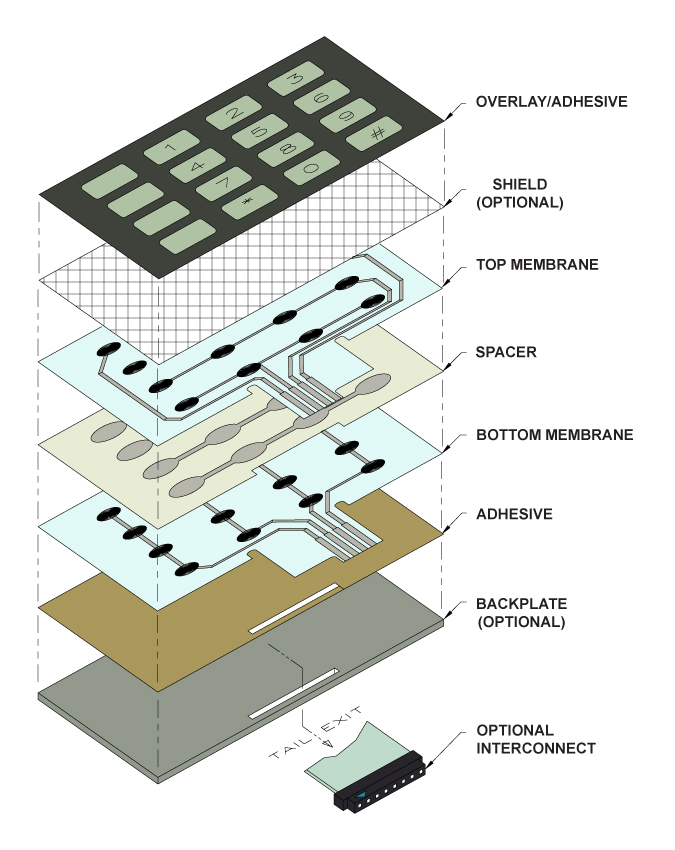Top Advantages of Integrating a Membrane Switch Into Your Digital Equipment
Top Advantages of Integrating a Membrane Switch Into Your Digital Equipment
Blog Article
Recognizing the Functionality of Membrane Changes for Interface Gadget
The functionality of membrane switches stands for a substantial improvement in user interface design, integrating efficiency with visual flexibility. As markets progressively focus on customer experience, comprehending the nuances of membrane layer switch innovation comes to be essential.
What Are Membrane Layer Switches?
Membrane layer buttons are innovative interface tools that promote individual interaction with digital tools. These flexible parts are composed of numerous layers, consisting of a graphic overlay, spacer, and a printed circuit layer. The design permits a seamless assimilation right into different electronic devices, enhancing both the aesthetic and practical aspects of interface.
Membrane switches are commonly utilized in a large range of applications, from household appliances to commercial machinery and medical tools. Their building and construction typically includes a thin profile, making them a perfect option for small layouts. The responsive responses offered by these switches can be crafted to meet certain individual choices, guaranteeing reliable communication in between the user and the gadget.
Toughness is an additional significant benefit of membrane switches, as they are immune to dirt, wetness, and chemicals, which improves their life-span in requiring atmospheres. In addition, these buttons can be tailored in terms of form, size, and visuals design, permitting branding and user-specific functions. Overall, membrane changes stand for a useful option for improving individual experience in digital tools, integrating capability with visual allure in an effective fashion.
Just How Membrane Layer Switches Over Job
Operating on a simple principle, membrane layer switches make use of a layered building to register customer input effectively. Each button includes numerous layers, including a published circuit layer, a spacer layer, and a top visuals layer, which are developed to function with each other effortlessly. When a customer presses the top layer, it compresses the spacer layer, bringing the conductive aspects of the circuit layer right into call with each other.
This call produces a shut circuit, signaling the tool to carry out a details feature. The style permits various configurations, including tactile feedback, which can boost the user experience by providing a physical feeling upon activation. The materials utilized in membrane layer buttons usually include versatile substrates, such as polyester or polycarbonate, which make sure resilience and strength versus damage.

Trick Advantages of Membrane Layer Switches

Another significant advantage is their density. Membrane switches are thin and light-weight, which allows producers to save area in their devices without sacrificing capability. This function is especially helpful in applications where weight and volume are essential considerations.
Furthermore, membrane layer buttons are immune to dirt, wetness, and chemicals, improving their longevity. This resilience prolongs their life-span and decreases the requirement for frequent replacements, leading to cost financial savings over time.
Furthermore, the tactile feedback offered by membrane layer buttons can be optimized to improve customer interaction. They can consist of functions such as increased buttons or distinct clicks, boosting use and user experience.
Applications Across Industries
Individual user interface tools using membrane switches prevail in a vast variety of markets, showcasing their adaptability and functionality. Membrane Switch. In the Go Here medical industry, membrane layer buttons are essential to tools such as diagnostic devices and client monitoring systems, where their longevity and simplicity of cleansing are critical for maintaining hygiene requirements. In the automotive industry, these buttons are employed in dashboard controls and infomercial systems, supplying a streamlined and modern-day user interface for individuals.
Additionally, the customer electronic devices sector take advantage of membrane buttons in appliances and portable tools, where portable design and user-friendly user interfaces improve user experience. Industrial applications webpage likewise utilize membrane switches over for control board in equipment and automation systems, emphasizing their robustness and resistance to severe settings.
In the aerospace and defense industries, membrane buttons are used in cockpit controls and devices, where reliability and efficiency under severe conditions are vital. Additionally, the video gaming sector increasingly incorporates membrane layer buttons in controllers and game makers, contributing to an interesting individual experience. Generally, the flexibility of membrane layer changes enables their prevalent usage across many industries, emphasizing their significance in modern interface design.
Future Fads in Membrane Layer Switch Over Innovation

Furthermore, the usage of innovative materials, such as polycarbonate and polyester movies, is anticipated to increase, supplying enhanced toughness and resistance to environmental stressors. These products add to the total long life of membrane layer switches, making them suitable for harsher commercial applications.
Furthermore, the incorporation of smart innovation, including IoT connection, will enable membrane layer buttons to communicate with various other tools and systems, assisting in a much more interactive customer experience. This trend aligns with the growing demand for smart devices throughout different industries, from healthcare to consumer electronics.
Lastly, personalization options are anticipated to increase, permitting makers to create bespoke remedies tailored to particular individual demands and preferences. These advancements will position membrane buttons as essential components in the evolution of interface technology.
Conclusion
In conclusion, membrane layer switches represent a critical development in customer interface technology, using a reliable and flexible remedy for varied electronic applications. As developments in material scientific research and touch picking up innovations continue, the capability and applicability of membrane layer switches are anticipated to expand, strengthening their relevance in modern-day digital gadgets.
Report this page